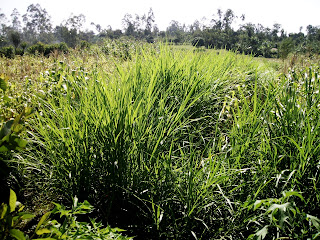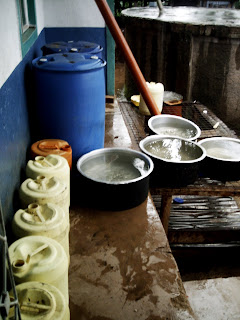During my time as a science major at Wabash College, I learned a lot of important information about water. If you asked me to condense my education about the substance down to a few important points, I would have to say that:
1. Water is the universal solvent (meaning that it can break down lots of substances over extended periods of time)
2. Water is unique because it’s the only substance to get less dense as it transforms from a liquid to a solid
And most importantly…
3. Life couldn’t exist without it.
When we visited Cairo, Egypt water was literally EVERYWHERE. Our hotel was right next to the Nile River, store vendors would use water to wash the concrete slabs in front of their venues every day, and there were water stands on every corner selling Americans and other tourists purified bottled water like the one in this picture. There was never a concern for obtaining water.
But in rural Kenya, water sources sometimes look like this…
In Kenya, practicing water conservation is essential. Although the country of Kenya touches Lake Victoria (which borders Kenya, Tanzania, and Uganda) it’s important to understand that the water from this lake doesn’t extend across the entire countries. In fact, several farmers in Northern Kenya are impoverished and starving because of the desertification occurring in this region. So it goes without saying that Kenyans understand how precious water is. Many of the Kenyans I know were never particularly fond of studying science, they don’t hold jobs in chemistry or environmental science, and most have never studied at the university level. However, they all understand that third piece of information that I learned at Wabash…
Life couldn’t exist without water
I once talked with a Kenyan school administrator who jokingly stated, “In Kenya, we have lots of water, but we don’t know what to do with it!” At first this statement was very confusing to me (given the information I just stated), but then I realized that he was referring to the rainy season. You see in Kenya, like many African countries, there is no “winter” season. So far I’ve met five Kenyans who have actually experienced snow. (3 Kenyan students studying in America, and 2 teachers here who got the opportunity to visit America) In Kenya there are dry seasons and rainy seasons…that’s it. Right now, we are in the rainy season, which means that it’s sunny and warm during the days, and it rains heavily during the nights.
Kenyans love the rainy seasons. It easily rains 6-10 inches (my estimation) everyday. During this time fruits and vegetables grow in abundance. You have the more noticeable crops that serve as staple foods
and grass for cows.
Interestingly, Americans feed our cows corn because we produce so much of it that we have excess. However, Kenyans only feed their cows grass. Grass-fed cow meat is MUCH healthier for you, but it takes the cows several years to get as big as our cows can in several months (thanks growth hormones!).
You also see lots of local Kenyan foods growing
During my time here I’ve also been introduced to exotic plants that bear some of my favorite fruits…
However, to maintain these crops every rainy season, Kenyan citizens must be aware of how the local plants are using the water. I can recall walking with Ben (our unofficial tour guide) one day when he showed us a row of trees that had been cut down. He explained that the wood would be used to repair bridges and construct houses like this one:
Immediately I asked, “Ben, why don’t Kenyans just grow bamboo? It grows three times as fast as other trees, and when layered, it’s just as strong as other types of wood!” Ben simply smiled and replied, “We could use bamboo which grows three times faster, but it would absorb three times as much water in the process.” That’s when I realized that as an American, I knew nothing about Kenyan water conservation. (I just got schooled!)
In fact, Kenyans do grow some bamboo, but only to use for fencing and other small projects.
The more common practice, instead, is to replace older trees that get cut down with young ones like these.
I got to be a part of the water conservation effort two days ago, when I happened to walk out onto the back porch during the evening rains. I noticed that Mora, the little girl whose family lives behind our host’s home, was frantically placing plastic tubs on the ground all along the edge of the roof. As I stared at her and the tubs, I realized that she was intentionally collecting rainwater from the roof. I had to take a picture…
It was the first time that I had noticed the special shape of the roofs that covered all the houses in this area. Their grooved shape is specially designed to collect rainwater!
Even the gutters of the house were designed so that rainwater could collect in strategically placed storage bins.
In case you’re wondering, rainwater is drinkable in some situations, but it’s still best to boil the water to kill any harmful bacteria or parasites.
Then, I saw a form of innovation that could only be described as SIMPLY-GENIUS. Wilemina’s son, Sam grabbed a long tube (simple) to funnel water into large storage bins on the back porch (genius).
The knowledge hit me like a ton of bricks. The water that we had been using to wash our hands…to clean our clothing…and to bathe in was THIS RAINWATER!
Even Mora, a third grader, understood how important this rainfall was, as depicted in this picture of her filling a plastic bin with some of the collected rain water.
(Pause for sanity’s sake…)
So, you know those moments when you realize that someone has been going out of their way to help you, and you’ve been taking them for granted? Well, that’s how I felt just then. I was using such a precious commodity and not even considering the work that others contributed to make me feel comfortable.
I felt compelled to “do my part” in this conservation act. I saw Sam begin to fill some smaller plastic containers with the rainwater. So I started grabbing plastic containers and helping him fill them all. Surprisingly, the work wasn’t very difficult, but it ensured that his family, Mora’s family, and David and I had ample water for the next few weeks.
Here are all the containers that we filled.
And here is a picture of the water drum that I never noticed outside of my room. I’m sure that the ingenious gutter system that fed into this drum filled it with just as much (if not more) water as the containers that I filled.
Thank you citizens of Kenya for helping me to think differently about the way we use water in America. In my apartment in Arkansas I would just turn a knob and water would come out of a faucet, or I would take a shower in GALLONS of drinkable water without thinking twice about it. Now I see that water is a precious resource and one that we shouldn’t take for granted. I can’t wait to get back to the US to figure out ways to maximize my water conservation.



















4 comments:
Excellent post and insight, Pbanks! Thanks for doing my work for me, I'll just copy and paste this into my participant workbook.... ;)
That's awesome. You forgot to mention the rainwater is FREE, one less bill :-)
Oh- and I am Kenyan. I did my undergrad in Environmental Science :-)
Pretty sure there's a fairly recent documentary about water that might interest you. Can't remember the title off the top of my head.
This is really interesting, thanks for sharing! I have those kinds of realizations all the time and generally feel like a giant pain in people's asses. Have fun collecting water!
Post a Comment